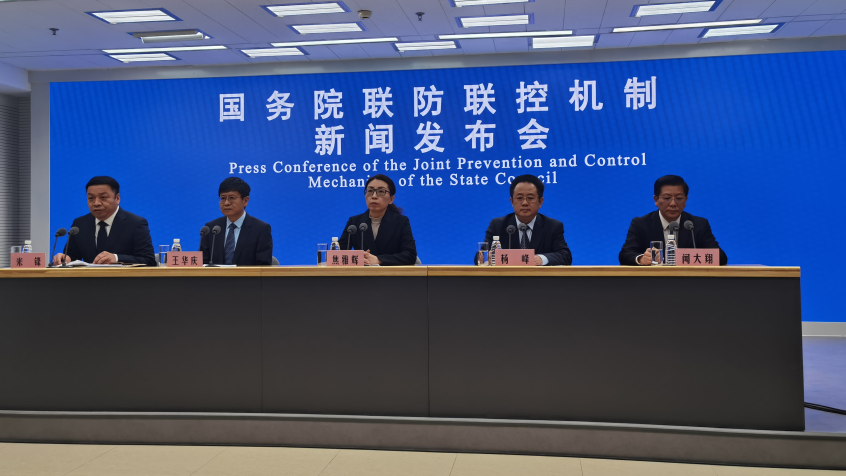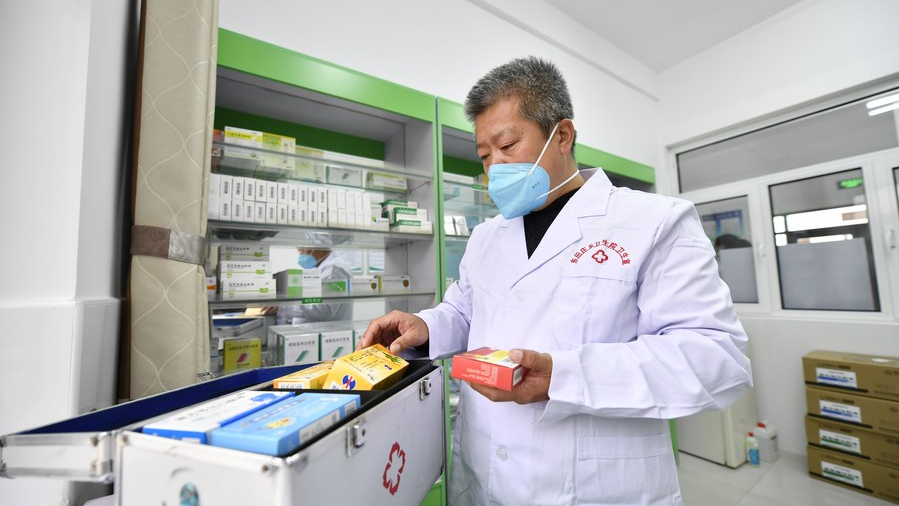
The Joint Prevention and Control Mechanism of the State Council holds a press conference in Beijing, China, January 14, 2023. /Xinhua
The Joint Prevention and Control Mechanism of the State Council holds a press conference in Beijing, China, January 14, 2023. /Xinhua
Editor's note: Yin Xiaoxv is a professor at the Department of Social Medicine and Health Management of Tongji Medical College under Huazhong University of Science and Technology. The article reflects the author's opinions and not necessarily those of CGTN.
The number of fever patients dropped to 477,000 on January 12, declining 83.3 percent from the peak daily figure, said Jiao Yahui, head of the Bureau of Medical Administration under the National Health Commission, at a press conference held by the State Council joint COVID-19 prevention and control mechanism on January 14. The number of people and COVID-19 detection rates at fever clinics across China have seen a downward trend since hitting its peak. Besides, among the recorded 59,938 COVID-related deaths between last December 8 and January 12, over 90 percent of them had other diseases such as cardiovascular problems, added Jiao.
As the transmissibility and pathogenicity of the coronavirus evolve, China's COVID-19 response measures have been constantly adjusted. From 20 prevention and control measures on further optimizing the COVID-19 response published in last November to 10 new measures rolling back COVID-19 restrictions in last December, and then to the downgrade in the management of COVID-19 as a Class-B infectious disease in January, the response efforts are science-based, precise and effective. In the face of the changing situation, it's crucial for China to focus on priorities of COVID-19 response and to ensure that the adjustment of response measures are carried out in a smooth and orderly manner.
As an important initiative in China's response to COVID-19, the joint prevention and control mechanism has played a vital role in the fight against the epidemic. In this new phase of COVID-19, China should continue to deepen inter-departmental cooperation on the basis of existing achievements and experiences, and bring into play the effective synergy of administrative departments, communities, primary healthcare institutions, general hospitals and disease control departments, in order to form a society-wide synergy of efforts.
While bringing together different stakeholders to ensure the smooth progress in COVID-19 response, the government should also highlight the new priority of "preventing serious cases" and uphold the concept of "putting people's life first," so that all measures can be coordinated and reinforce each other.
At the community level, the government should promote a shift from "management and control" to "service and health protection" and give full play to the function of the community as the fabrics of the "health protection network." The role of community-level administrative organizations should be strengthened, and community resources (such as volunteers and property management service providers) should be further mobilized and brought into the health protection campaign.
Efforts should be made to step up the provision of community living services, health care services and psychological services to patients. Attention should be paid to the real-time monitoring of the health status of vulnerable groups, as well as the medical treatment and basic needs of vulnerable groups such as infants and children, the elderly, people with underlying conditions, pregnant women, and people with disabilities and dementia. Community-specific emergency plans should be developed according to local realities as part of the efforts to establish a sound governance system.
According to hierarchical medical treatment system, the majority of common health issues should be treated at grassroots medical institutions. Therefore, the function of primary healthcare institutions should be further strengthened as the fabrics of the "medical care provision network." Relying on the integrated medical consortium, a multi-tier diagnosis and care delivery network for triage treatment of COVID-19 patients should be built, forming a two-way mechanism featuring both "top-down" and "bottom-up" care provision. The aim is to provide systematic and continuous stratified care services for COVID-19 patients.

Doctor Sun Qingliang prepares medicines for home visits at a village clinic in Wangdadiao Village, Fengnan District of Tangshan City, north China's Hebei Province, January 11, 2023. /Xinhua
Doctor Sun Qingliang prepares medicines for home visits at a village clinic in Wangdadiao Village, Fengnan District of Tangshan City, north China's Hebei Province, January 11, 2023. /Xinhua
In addition, it is necessary to activate the flexible response capacity of primary healthcare institutions and fully tap into the existing resources. For example, in Suzhou City of east China's Jiangsu Province, in order to improve the capacity of primary healthcare institutions to treat fever patients, many sidewalk facilities originally used as part of the nucleic acid testing process were converted into temporary fever consulting rooms to provide one-stop healthcare services for local residents. The repurposed roadside booths can be used for treating patients with mild symptoms, thus preventing the overcrowding of hospitals.
General hospitals, as the main care providers for COVID-19 patients, should focus on treating severe cases and providing emergency care. Although the rate of serious illness caused by Omicron has decreased significantly, given the high number of elderly people and patients with underlying diseases in China, the absolute number of patients who may get seriously ill cannot be underestimated.
Therefore, general hospitals should keep optimizing their diagnosis and treatment processes for COVID-19 patients, integrate and coordinate medical resources, increase the number of beds, properly allocate medical and nursing staff, and provide theoretical and practical training for medical and nursing staff on handling critical illnesses to ensure that they are always "combat-ready" when the demand for critical illness care increases.
The disease control departments are the gatekeepers of epidemic response. Key hospitals or primary healthcare institutions should act as sentinel sites to strengthen the monitoring of the virus mutation, understand the trend of virus mutation in real time, capture new variants in time, analyze the biological characteristics and case symptoms, and provide a scientific basis for the research of epidemic trends and optimization measures.
Moreover, attention should be paid to the sampling among key populations and sites, such as inbound personnel, aviation personnel, railway stations, bus stations and airports, in order to stay in high alert to new variants imported from abroad and to improve the monitoring system.
Finally, it's necessary to further enhance the foresight and take pre-emptive measures in controlling the epidemic, as part of the efforts to weave a closely-knit network for COVID-19 response. As the Lunar New Year approaches, the nationwide travel rush has already begun. Given the weak medical infrastructures in rural areas, such a massive human movement is likely to lead to another wave of infections.
Therefore, it is necessary to step up the monitoring of the health status of vulnerable people in rural areas, to identify and transfer infected people at higher risk of serious illness in a timely manner. Priority must be given to ensuring the availability of medicine and other protective resources in rural health centers and elderly care institutions, so that these areas can weather through the possible infection wave.
Over the past three years, China has kept optimizing its COVID-19 response measures, each time building on previous experiences. China plans the strategy for the new phase in advance, and sets out the new priorities to ensure a smooth and orderly transition. This can help balance the epidemic prevention and control with social and economic development, maintain the order of production and life of the general public, and safeguard the fundamental interests of the Chinese people.
(If you want to contribute and have specific expertise, please contact us at opinions@cgtn.com. Follow @thouse_opinions on Twitter to discover the latest commentaries in the CGTN Opinion Section.)